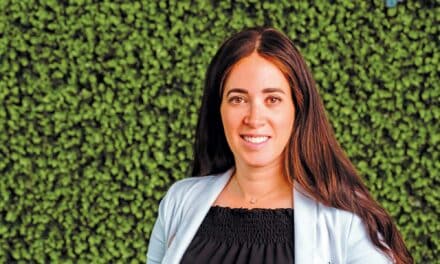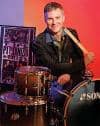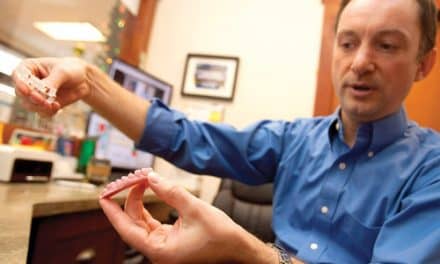Over 30 years, Kevin P. Lucas, DDS, has built a reputation treating complex, multi-disciplinary adult cases that require clinical products he can trust to ensure life-changing outcomes.
By Greg Thompson | Photos by Caplan Studios Photography
Kevin P. Lucas, DDS, has been in private practice for more than three decades. As the owner of Illinois-based Lucas Orthodontics, he has seen the evolution of numerous trends and countless technological advances—some overhyped and some transformational.
“When I went to dental school, we didn’t have scanners,” says Lucas, who did his undergrad and dental school at the University of Illinois. “We took impressions and did everything old school, so you really had to be much better with your hands back then.”
As a boy, Lucas cultivated his mechanical talents by taking apart lawn mowers and putting them back together. Parts may have been leftover, he says with a chuckle, but the engine usually worked.
The fine motor skills of dentistry, and ultimately orthodontics, appealed to the young Lucas who worked a summer construction job to pay for college. “I was thinking about dental school, so the crew always had me drilling holes in concrete,” he remembers. “They said I needed more practice drilling for dental school.”
The construction job continued during dental school breaks with one project involving the remodeling of an orthodontist office. Lucas struck up a friendship with the orthodontist who owned the space and the practitioner eventually became a valued mentor. After completing his orthodontic residency at the University of Pennsylvania, Lucas became an associate at his mentor’s practice.
After a few years, Lucas seized an opportunity to open his own practice in his hometown of Buffalo Grove, Ill. “I started from scratch,” he says. “I had two patients scheduled per day—one at 8:30 am and the other at 4:30 pm I sat there all day and hoped the phone would ring. I needed more patients, so I got involved in the community—coaching sports, sponsoring every school event possible, and just trying to be personable. I kept the original scheduling book as a way to keep me humble as I look back to how the practice has grown.”
For about a dozen years now, the 63-year-old Lucas has also operated a 4,000-square-foot satellite office in Lake In The Hills, in addition to the main office in Buffalo Grove. Nine staff members, including one part-time associate, keep both locations humming in a space that features six chairs in an open bay setup. With adults making up a third of the patient mix, two of the chairs are designed for adult treatment.

The challenging adult cases
“I tend to get all the challenging adult patients,” Lucas reveals. The reputation for expertise in tough adult cases has blossomed, thanks partly to Lucas’ role in teaching adult orthodontics and orthognathic surgery to second year residents at the University of Pennsylvania. “Anything surgical comes my way,” Lucas says, “and dentists/prosthodontists who recognize how orthodontics can benefit their patients prior to the restorative plan send their more difficult cases to me.”
Over the last 30 years teaching at Penn, Lucas has trained more than 250 orthodontic residents in adult orthodontics and jaw surgery. The teaching involves flights to Philadelphia every other month, plus a full day spent with the residents. “In preparation I’ll send them pretreatment records for adult skeletal discrepancy cases, and they need to work up what should be done,” Lucas explains. “When I’m out there, I spend the day reviewing the treatment options. Whether it be combined orthodontics, orthognathic surgery, or orthodontics alone—we figure out how to address the problem.”
A side benefit of treating more adults is increased referrals of friends and neighbors. The exposure means that Lucas performs roughly 20 to 25 jaw surgery cases per year, with the help of an oral surgeon. Many adult cases involve multiple missing teeth that need to be treated orthodontically. Of course, most adults want to be treated with aligners. Because of the complexity, many of these cases require braces and can’t be treated with aligners.
It’s not unusual for patients who need surgery to fly in from Boston, Florida, or even Texas. It adds an element of pressure and Lucas confesses, “When I have people flying from so far away, I need to be on top of my game. I also need to use products that are reliable and give me the results that I need.”

A need for reliable products
As mostly a wait-and-see practitioner when it comes to technology, Lucas wants to be on the cutting edge, but only using “tried and true” methods that work for patients. In his 30-plus years, more tech has not always meant better tech.
With computer-aided systems to help bend wires and move teeth, Lucas reports: “It was very expensive, and maybe it was for orthodontists who never were comfortable bending wires to detail a case. That company, which shall remain nameless, eventually evolved and realized that a large number of orthodontists were not using these wires, so now they make aligners instead.”
As any private practice owner knows, sales reps routinely tout their wares in hopes of gaining new clients. One of these calls involved a rep from TP Orthodontics, a venerable entity based in La Porte, Indiana. The rep dropped off products and Lucas started using them, at first with a measure of caution and even skepticism.
“I really liked what I saw,” he says. “They had this InVu bracket. It was a ceramic bracket that matched the tooth color very nicely for adults. They have a color matching technology, so it was almost invisible on the teeth. The way the light passes through the bracket matches the color of the teeth. Some braces don’t look natural, but this aesthetic bracket looked fantastic and TPO makes a certain type of wire with a proprietary natural color Teflon coating that matches the teeth and the bracket.”
Particularly with the InVu brackets, Lucas appreciates the ease of placement, but he also reports: “The big thing is the ease of removal of the bracket. The hardest thing for an orthodontist is to remove a clear brace without damaging the tooth. InVu brackets have a flexible polymer base that functions as a safety interface between the bracket and the tooth. And, with other companies, the coating on their aesthetic or white covered wires would come off within a few days after the wires were in place, and the patients were getting upset. That does not happen with TPO wires.”
Lucas started using the TPO lab to make retainers and/or expanders, but one day one of the expanders was not fitting right. In response, a rep from the TPO lab drove 2 hours to Buffalo Grove to address the problem. “TPO products are made in America and are excellent quality,” Lucas says. “Everyone from the executives to the manager of the lab are there for you when you need them.
“I’ve been doing this so long now that I know what products are quality and what works,” he continues. “I’m not the new guy out of school trying multiple different products. I like what I use because it works fantastically well, has great outcomes, and is ideal for me and my patients.”
Lucas uses a “fair amount” of aligners on adults in his practice when warranted, but he’s quick to point out that aligners “cannot always give you the result that braces can.” On the topic of those “old school skills,” Lucas concedes that some adults appreciate the tried and true approach, remarking that: “Maybe part of the reason my practice has evolved more toward adults is because I have the skills from years ago learning how to bend wires and place brackets—instead of using plastic to move teeth.”
Lucas uses TPO products on patients from seven to age 85 and interceptive (Phase I) treatment is a large part of the practice. Palate expansion appliances, habit appliances, and minor tooth movement appliances are commonly used on younger patients. These help develop the arches in growing patients and decrease the time in braces when needed.

Pandemic to now
As with most orthodontic offices, the Covid pandemic resulted in a “huge increase” in adult patients going through treatment at Lucas Orthodontics, mainly because patients were home from their jobs, with many working remotely. Malocclusions were hidden with masks, but at the same time it brought home the importance of a great smile.
Lucas continues to see growth every year and counts his satellite office as a crucial addition.
“The biggest challenge for me is that when you have adults in the chairs it takes so much more time because they have so many more questions,” he explains. “I have to be more involved in the mechanics of what we’re doing in the mouth. There is constant communication with the periodontist, the oral surgeon, and the prosthodontist. Photographs, radiographs, and study models are being exchanged.”
The life-changing effects of jaw surgery on patients can be remarkable. Lucas and his team have not only improved the facial esthetics of these patients but have also improved their jaw function and long-term health of the teeth. In addition, many of these patients have better digestive health because they can now chew food properly. As it is with many colleagues, some cases stand out more than others.
Lucas remembers: “One patient was born without part of his lower jaw—the condyles—essentially the area of the lower jaw that articulates with the skull. He basically had no chin and would walk around with his hand in front of his mouth. He grew a beard on his lower jaw to make it look like he had a chin. We set him up orthodontically to have surgery and reconfigure his middle face and lower jaw. It made a huge difference in how he looked…It was rewarding to see someone who was embarrassed by how he looked turn into someone who was confident and more social.”
Success has led to steady growth over many years, but even with the growth, Lucas Orthodontics is not a high-volume practice—with around 60 to 70 patients per day. In accordance with a “semi-boutique” philosophy, Lucas says, “Fees are on the higher end. We want to be the Neiman Marcus of orthodontics, so we’re going to kill them with quality of service—and they’re not going to be rushed in and out of the office without all their questions being answered. You can have a boutique practice, or you can have a high volume practice, and I have something probably in the middle.”

Biscuit in the basket
Right around 2004, Lucas started the Northern Illinois Dental Specialist Study Group, a collection of five orthodontists who each invited a periodontist and an oral surgeon—plus two prosthodontists. The group meets quarterly to go over difficult multi-disciplinary cases and figure out better ways to help patients. Twenty years on, it’s one of the premiere groups in the area.
With clinical skills continually honed, Lucas is keen to emphasize that scientific acumen is only one part of the full tool kit. “Personality and people skills are the key to growing a practice,” he says. “I always like to find something in common with every new patient who comes in, whether it’s sports, activities, children, where they grew up. Building that relationship is the first step in growing the practice. You must show that you care and then the orthodontics is fun.”
It all amounts to a busy schedule, but Lucas takes pains to have a balanced life. He works four days a week and takes off one week per month. He has three adult children in college, with the oldest (a son) in his first year of dental school—and a likely candidate to take over the practice someday.
These days, spare time is devoted to playing on two men’s hockey teams and satisfying the need for speed. “I collect sports cars and I love to race Porsches,” he admits. “As for hockey, the guys know I can put their teeth back in or fix their teeth. There are times when I’ve been at the office at midnight after a game putting a tooth back in that someone knocked out and splinting it in place. I play offense because I want to be in the mix of scoring, whether it’s setting up my teammate or putting the biscuit in the basket.”OP
Greg Thompson is a freelance writer for Orthodontic Products.










